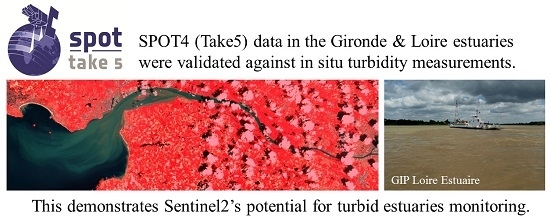Toward Sentinel-2 High Resolution Remote Sensing of Suspended Particulate Matter in Very Turbid Waters: SPOT4 (Take5) Experiment in the Loire and Gironde Estuaries
Abstract
:1. Introduction
2. Material and Methods
2.1. Study Sites
2.1.1. Gironde Estuary
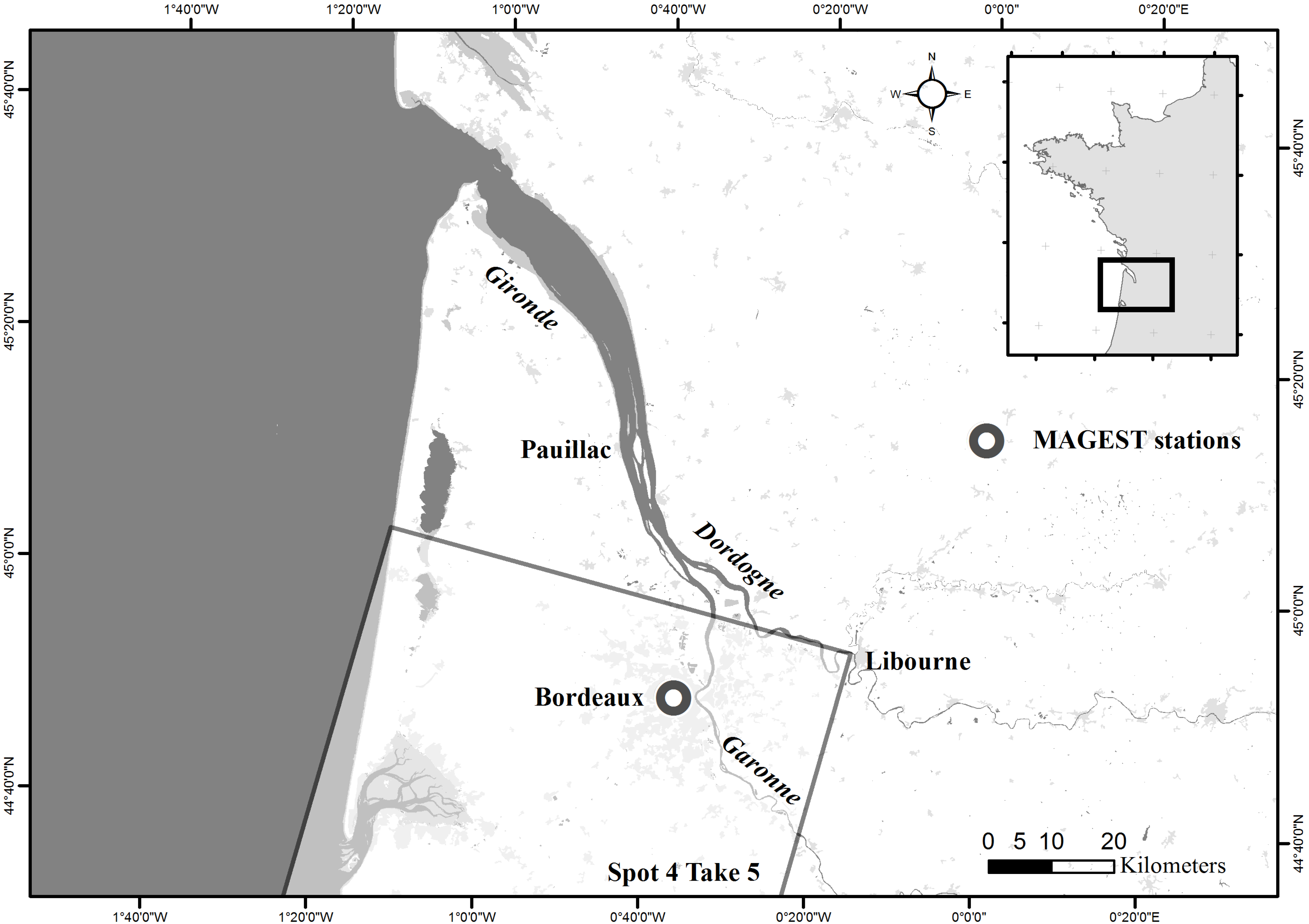
2.1.2. Loire Estuary
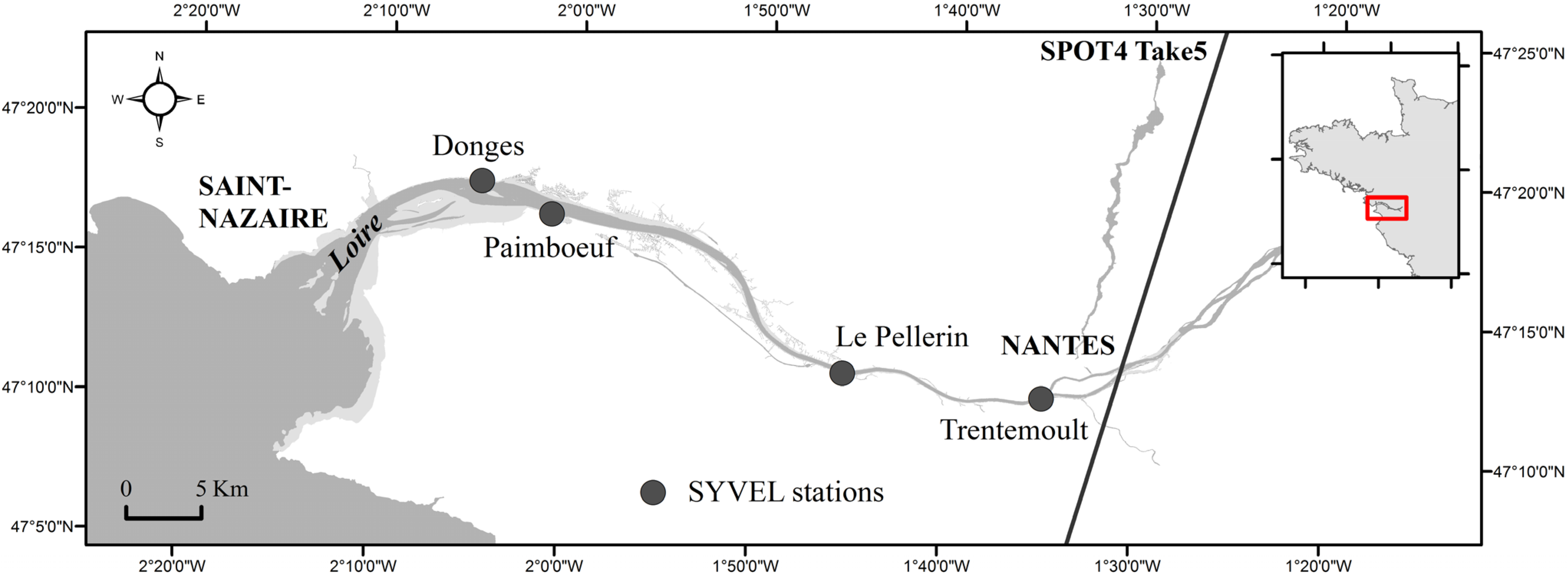
2.2. SPOT4 (Take5) Experiment in the Gironde and Loire Estuaries
| Band Number | Central Wavelength (nm) | Band Width (nm) | Spatial Resolution (m) |
|---|---|---|---|
| 1 | 443 | 20 | 60 |
| 2 | 490 | 65 | 10 |
| 3 (XS1) | 560 (545) | 35 (90) | 10 (20) |
| 4 (XS2) | 665 (645) | 30 (70) | 10 (20) |
| 5 | 705 | 15 | 20 |
| 6 | 740 | 15 | 20 |
| 7 | 783 | 20 | 20 |
| 8 (XS3) | 842 (835) | 115 (110) | 10 (20) |
| 8b | 865 | 20 | 20 |
| 9 | 940 | 20 | 60 |
| 10 | 1375 | 30 | 60 |
| 11 (XS4) | 1610 (1665) | 90 (170) | 20 (20) |
| 12 | 2190 | 180 | 20 |
2.3. Validation Dataset
2.3.1. In Situ Turbidity Measurements in the Gironde Estuary
2.3.2. In Situ Turbidity Measurements in the Loire Estuary
2.3.3. Evaluation of SPM Algorithm Performance
3. Results
3.1. Satellite Data Summary
| Date | Sensor | Acquisition Time (UT) | Low Tide (UT) | Tidal Range (m) | Water Height (m) | River Flow (m3·s−1) |
|---|---|---|---|---|---|---|
| 10 January 2011 | Landsat5 | 10:40 | 04:56 | 4.45 | 4.42 | 317 |
| 7 March 2011 | Landsat7 | 10:41 | 15:34 | 5.15 | 2.89 | 471 |
| 8 April 2011 | Landsat7 | 10:42 | 16:27 | 4.60 | 3.59 | 482 |
| 2 May 2011 | Landsat5 | 10:40 | 13:34 | 4.75 | 1.54 | 253 |
| 5 July 2011 | Landsat5 | 10:40 | 16:53 | 5.10 | 3.82 | 97 |
| 23 September 2011 | Landsat5 | 10:40 | 09:25 | 3.60 | 1.79 | 116 |
| 1 October 2011 | Landsat7 | 10:41 | 16:40 | 3.35 | 3.76 | 99 |
| 18 November 2011 | Landsat7 | 10:42 | 05:45 | 4.00 | 4.46 | 294 |
| 20 February 2013 | SPOT4 | 10:18 | 09:02 | 3.30 | 1.69 | 1120 |
| 7 March 2013 | SPOT4 | 10:17 | 09:28 | 4.00 | 0.88 | 581 |
| 21 April 2013 | SPOT4 | 10:13 | 09:59 | 3.95 | 0.43 | 978 |
| 5 June 2013 | SPOT4 | 10:09 | 11:34 | 4.25 | 0.80 | 1650 |
| 10 July 2013 | Landsat8 | 10:50 | 15:13 | 4.75 | 2.42 | 393 |
| 11 August 2013 | Landsat8 | 10:49 | 16:35 | 4.90 | 3.48 | 291 |
| 30 October 2013 | Landsat8 | 10:49 | 10:06 | 3.80 | 1.10 | 178 |
| Date | Acquisition Time (UT) | Low Tide (UT) | Tidal Range (m) | Water Height (m) | River Flow (m3·s−1) |
|---|---|---|---|---|---|
| 6 February 2013 | 09:58 | 05:49 | 3.05 | 4.09 | 3200 |
| 21 February 2013 | 09:57 | 06:55 | 2.24 | 3.55 | 2080 |
| 28 March 2013 | 09:54 | 10:38 | 5.55 | 0.83 | 1400 |
| 17 April 2013 | 09:53 | 14:22 | 2.25 | 4.14 | 2410 |
| 27 May 2013 | 09:49 | 11:23 | 5.37 | 1.61 | 2400 |
3.2. Range of SPM Concentration during SPOT4 (Take5) Experiment
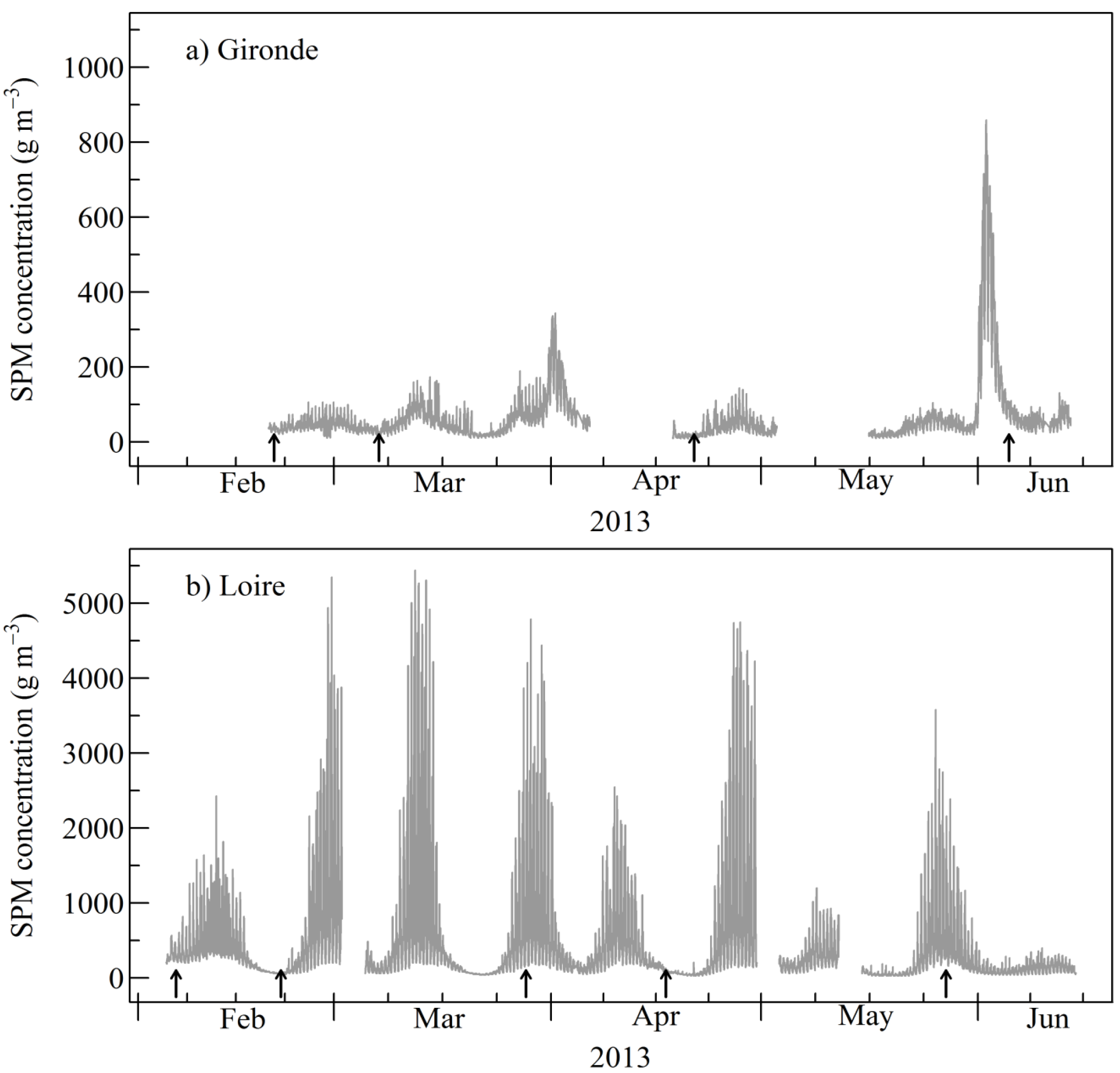
3.3. SPM Match-Ups in the Gironde and Loire Estuaries
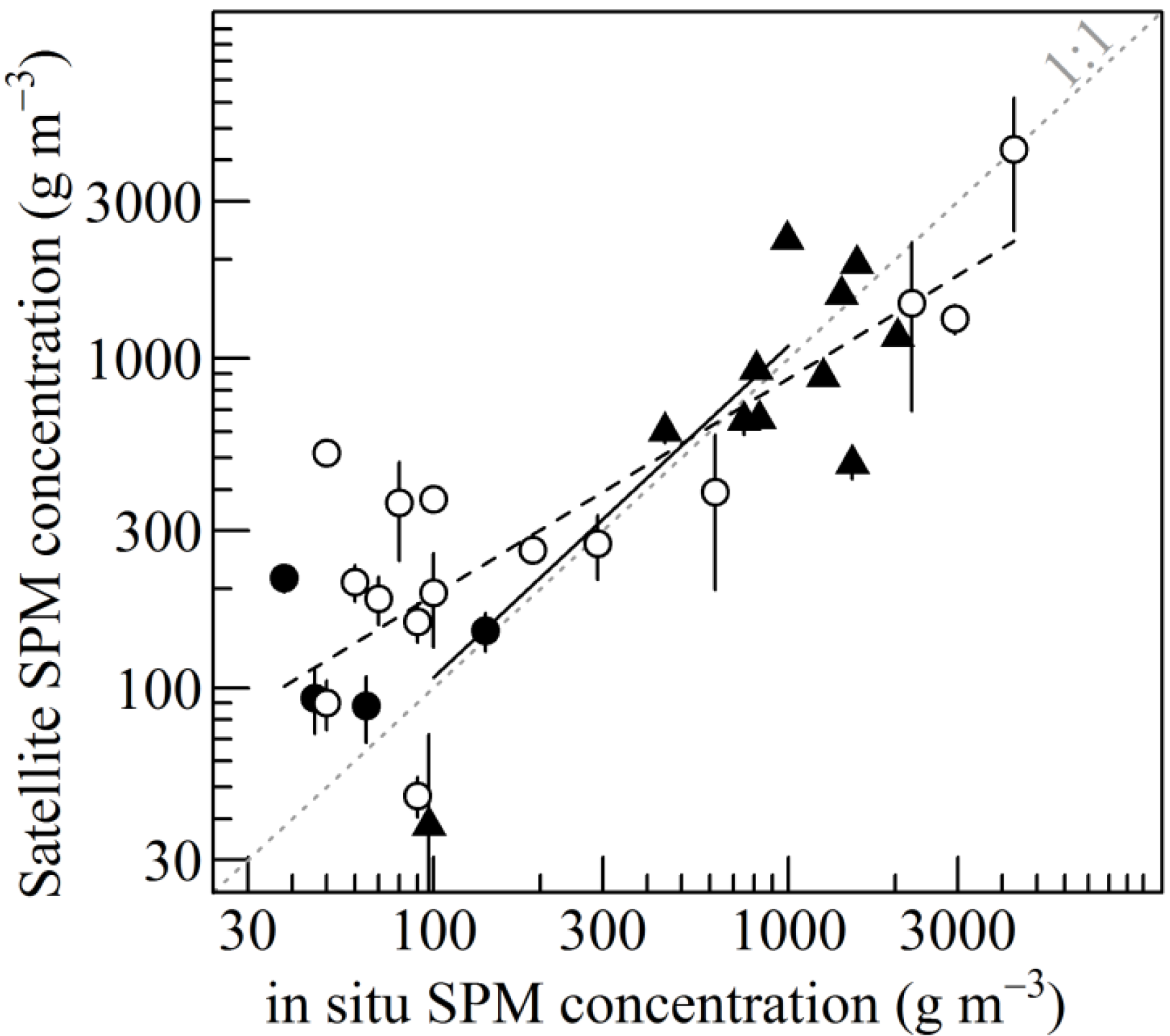
3.4. SPM Spatial Distribution in the Gironde and Loire Estuary
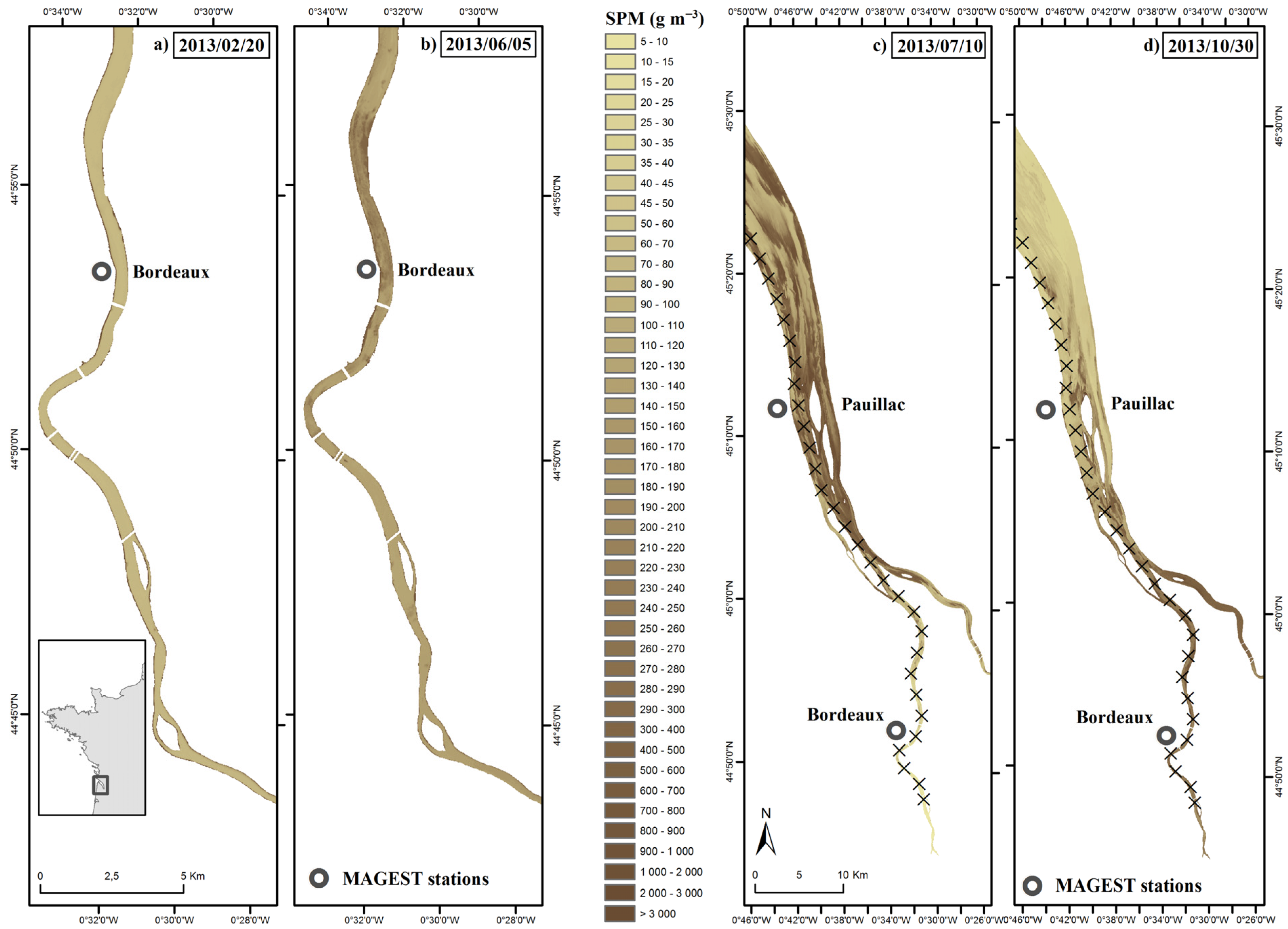
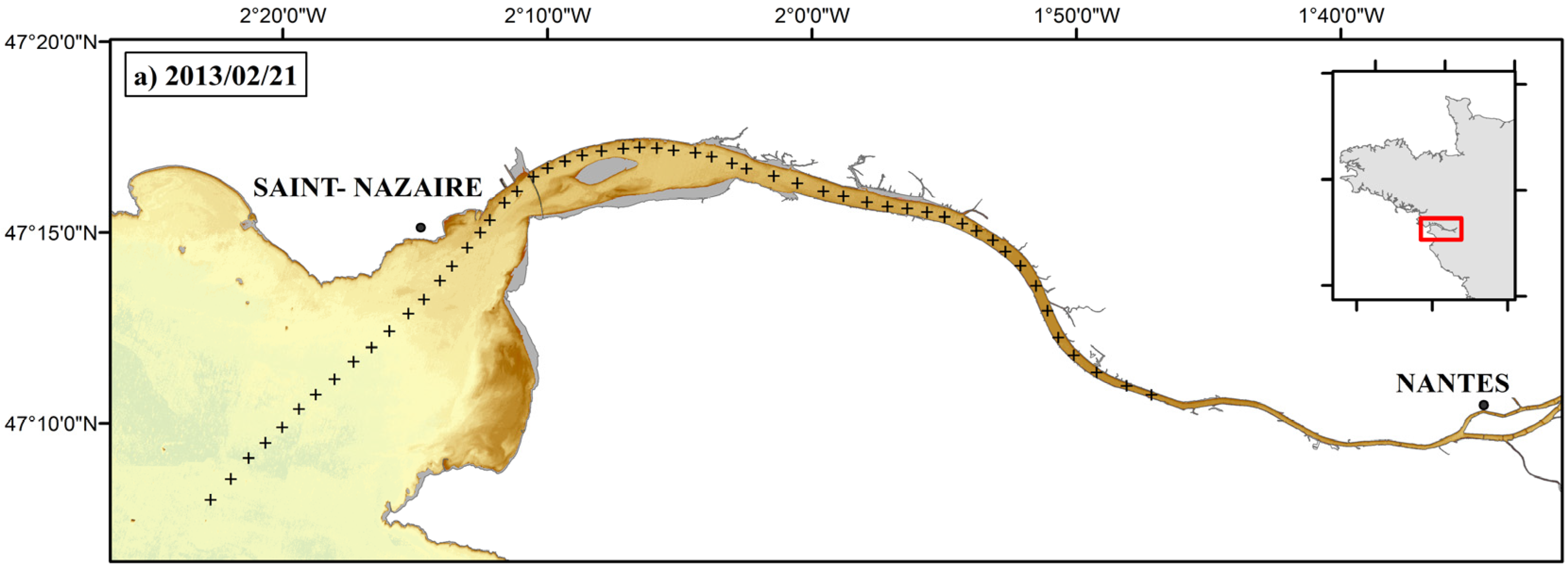
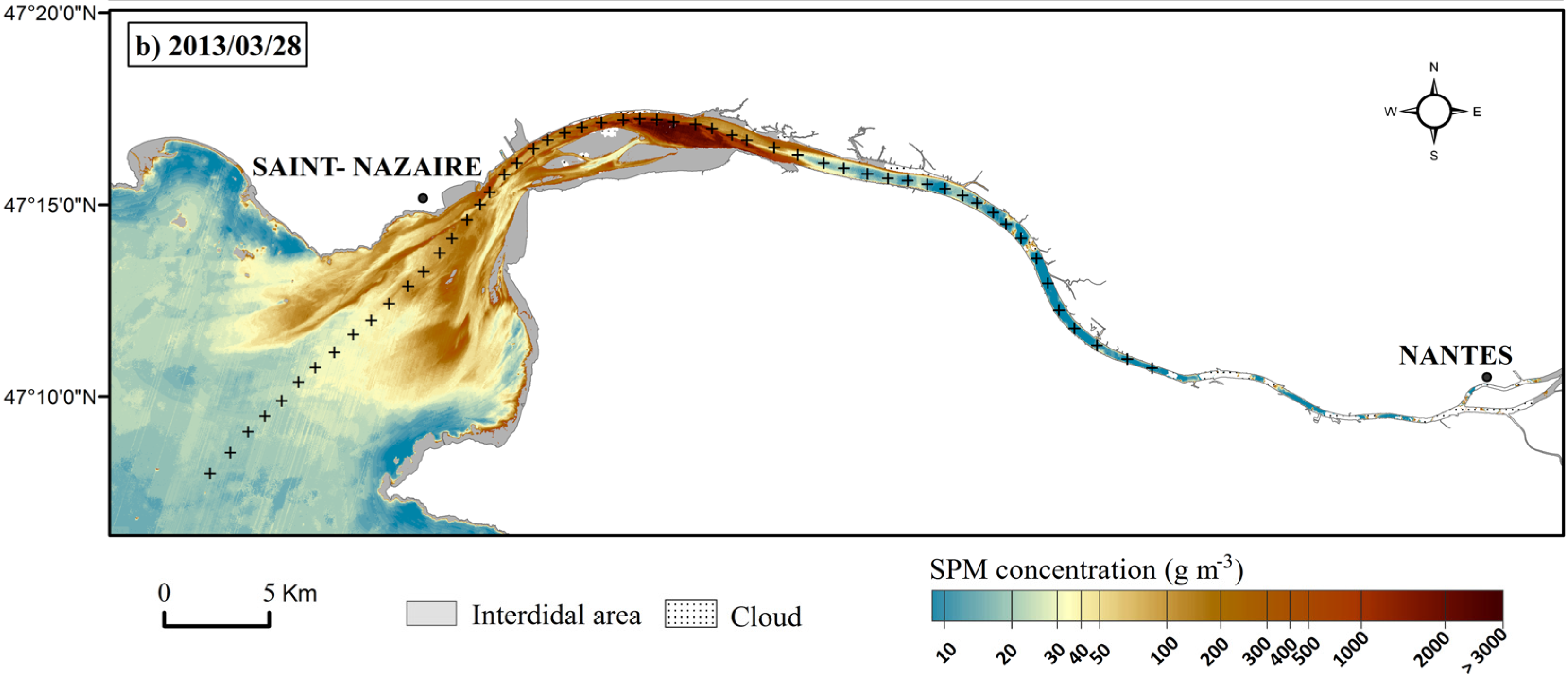
3.4.1. SPM Concentration Maps in the Gironde Estuary
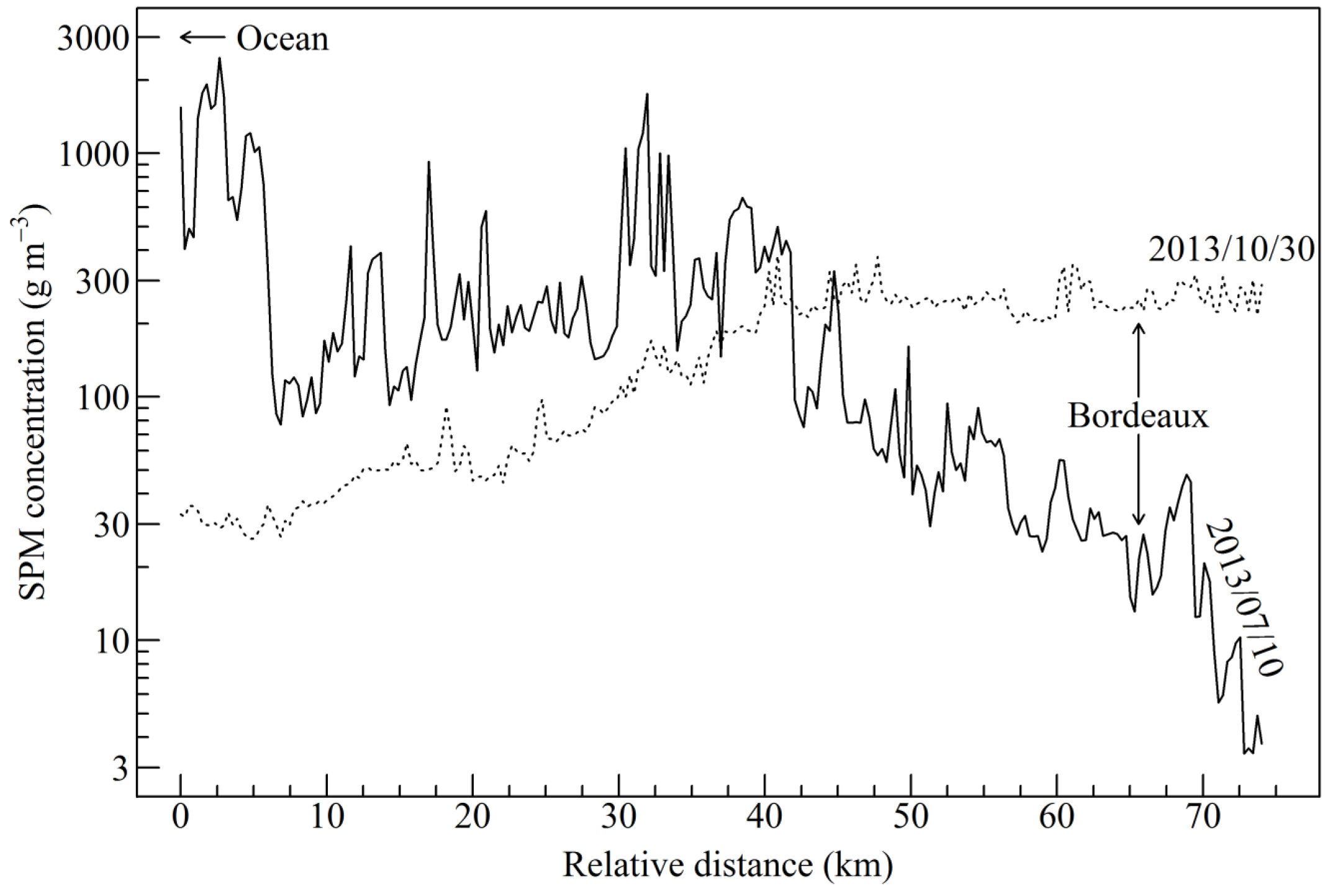
3.4.2. SPM Concentration Maps in the Loire Estuary

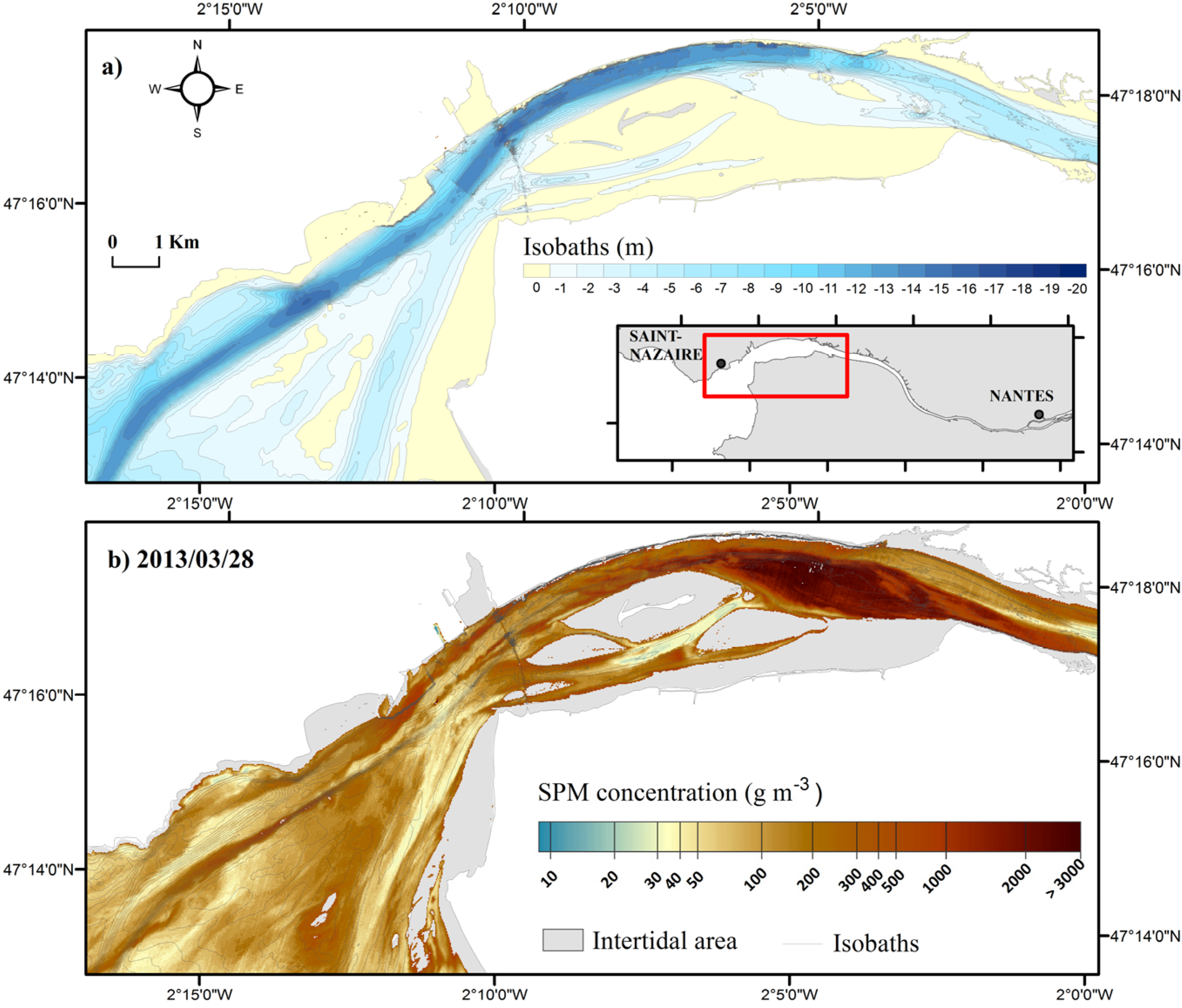
4. Discussion
4.1. Accuracy of Satellite-derived SPM Concentration Maps
4.1.1. In Situ Measurements Uncertainties
4.1.2. Spatial Heterogeneity and Match-Up Pixel Selection
4.1.3. Validity Range of the Doxaran et al. (2003) Algorithm
4.1.4. Atmospheric Correction
4.2. Influence of Environment on SPM Dynamics
5. Conclusions and Future Directions
Acknowledgments
Author Contributions
Conflicts of Interest
References
- Avoine, J.; Allen, G.P.; Nichols, M.; Salomon, J.C.; Larsonneur, C. Suspended-sediment transport in the Seine estuary, France: Effect of man-made modifications on estuary—Shelf sedimentology. Mar. Geol. 1981, 40, 119–137. [Google Scholar] [CrossRef]
- Figueres, G.; Martin, J.M.; Meybeck, M.; Seyler, P. A comparative study of mercury contamination in the Tagus Estuary (Portugal) and major French Estuaries (Gironde, Loire, Rhône). Estuar. Coast. Shelf Sci. 1985, 20, 183–203. [Google Scholar] [CrossRef]
- Budzinski, H.; Jones, I.; Bellocq, J.; Pierard, C.; Garrigues, P.H. Evaluation of sediment contamination by polycyclic aromatic hydrocarbons in the Gironde estuary. Mar. Chem. 1997, 58, 85–97. [Google Scholar] [CrossRef]
- Fredsøe, J.; Deigaard, R. Mechanics of Coastal Sediment Transport; Advanced Series on Ocean Engineering; Liu, P.L.-F., Ed.; World Scientific: Singapore, 1992; Volume 3, p. 369. [Google Scholar]
- Irigoien, X.; Castel, J. Light limitation and distribution of chlorophyll pigments in a highly turbid estuary: The Gironde (SW France). Estuar. Coast. Shelf Sci. 1997, 44, 507–517. [Google Scholar] [CrossRef]
- Etcheber, H.; Schmidt, S.; Sottolichio, A.; Maneux, E.; Chabaux, G.; Escalier, J.M.; Wennekes, H.; Derriennic, H.; Schmeltz, M.; Quéméner, L.; et al. Monitoring water quality in estuarine environments: Lessons from the MAGEST monitoring program in the Gironde fluvial-estuarine system. Hydrol. Earth Syst. Sci. 2011, 15, 831–840. [Google Scholar] [CrossRef]
- Marchand, J. The influence of seasonal salinity and turbidity maximum variations on the nursery function of the Loire estuary (France). Neth. J. Aquat. Ecol. 1993, 27, 427–436. [Google Scholar] [CrossRef]
- Turner, A.; Millward, G.E. Suspended particles: Their role in estuarine biogeochemical cycles. Estuar. Coast. Shelf Sci. 2002, 55, 857–883. [Google Scholar] [CrossRef]
- Meybeck, M.; Cauwet, G.; Dessery, S.; Somville, M.; Gouleau, D.; Billen, G. Nutrients (organic C, P, N, Si) in the eutrophic river Loire (France) and its estuary. Estuar. Coast. Shelf Sci. 1988, 27, 595–624. [Google Scholar] [CrossRef]
- Wollast, R. Interactions in estuaries and coastal waters. In The Major Biogeochemical Cycles and Their Interactions, Scientific Committee on Problems of the Environment (SCOPE); Bolin, B., Cook, R.B., Eds.; John Wiley & Sons: New York, NY, USA, 1983; Chapter 14; pp. 385–407. [Google Scholar]
- Uncles, R.J.; Stephens, J.A. Distribution of suspended sediment at high water in a macrotidal estuary. J. Geophys. Res. 1989, 94, 14395–14405. [Google Scholar] [CrossRef]
- Geyer, W.R. The importance of suppression of turbulence by stratification on the estuarine turbidity maximum. Estuaries 1993, 16, 113–125. [Google Scholar] [CrossRef]
- Sholkovitz, E.R. Flocculation of dissolved organic and inorganic matter during the mixing of river water and seawater. Geochim. Cosmochim. Acta 1976, 40, 831–845. [Google Scholar] [CrossRef]
- Mitchell, S.B.; Lawler, D.M.; West, J.R.; Couperthwaite, J.S. Use of continuous turbidity sensor in the prediction of fine sediment transport in the turbidity maximum of the Trent Estuary, UK. Estuar. Coast. Shelf Sci. 2003, 58, 643–650. [Google Scholar] [CrossRef]
- Doxaran, D.; Froidefond, J.M.; Castaing, P. Reflectance band ratio used to estimate suspended matter concentrations in coastal sediment-dominated waters. Int. J. Remote Sens. 2002, 23, 5079–5085. [Google Scholar] [CrossRef]
- Rouse, L.J.; Coleman, J.M. Circulation observations in the Louisiana Bight using LANDSAT imagery. Remote Sens. Environ. 1976, 5, 55–66. [Google Scholar] [CrossRef]
- Mertes, L.A.; Smith, M.O.; Adams, J.B. Estimating suspended sediment concentrations in surface waters of the Amazon River wetlands from Landsat images. Remote Sens. Environ. 1993, 43, 281–301. [Google Scholar] [CrossRef]
- Doxaran, D.; Castaing, P.; Lavender, S.J. Monitoring the maximum turbidity zone and detecting fine-scale turbidity features in the Gironde estuary using high spatial resolution satellite sensor (SPOT HRV, Landsat ETM+) data. Int. J. Remote Sens. 2006, 27, 2303–2321. [Google Scholar] [CrossRef]
- Heege, T.; Kiselev, V.; Wettle, M.; Hung, N.N. Operational multi-sensor monitoring of turbidity for the entire Mekong Delta. Int. J. Remote Sens. 2014, 35, 2910–2926. [Google Scholar] [CrossRef]
- Forget, P.; Ouillon, S. Surface suspended matter off the Rhone river mouth from visible satellite imagery. Oceanol. Acta 1998, 21, 739–749. [Google Scholar] [CrossRef]
- Shi, Z.; Kirby, R. Observations of fine suspended sediment processes in the turbidity maximum at the North Passage of the Changjiang Estuary, China. J. Coast. Res. 2003, 19, 529–540. [Google Scholar]
- Jiang, X.; Lu, B.; He, Y. Response of the turbidity maximum zone to fluctuations in sediment discharge from river to estuary in the Changjiang Estuary (China). Estuar. Coast. Shelf Sci. 2013, 131, 24–30. [Google Scholar] [CrossRef]
- Doxaran, D.; Froidefond, J.M.; Castaing, P.; Babin, M. Dynamics of the turbidity maximum zone in a macrotidal estuary (the Gironde, France): Observations from field and MODIS satellite data. Estuar. Coast. Shelf Sci. 2009, 81, 321–332. [Google Scholar] [CrossRef]
- Eleveld, M.A.; van der Wal, D.; van Kessel, T. Estuarine suspended particulate matter concentrations from sun-synchronous satellite remote sensing: Tidal and meteorological effects and biases. Remote Sens. Environ. 2014, 143, 204–215. [Google Scholar] [CrossRef]
- Zheng, G.; DiGiacomo, P.M.; Kaushal, S.S.; Yuen-Murphy, M.A.; Duan, S. Evolution of sediment plumes in the Chesapeake Bay and implications of climate variability. Environ. Sci. Technol. 2015. [Google Scholar] [CrossRef] [PubMed]
- Doxaran, D.; Froidefond, J.M.; Castaing, P. Remote-sensing reflectance of turbid sediment-dominated waters. Reduction of sediment type variations and changing illumination conditions effects by use of reflectance ratios. Appl. Opt. 2003, 42, 2623–2634. [Google Scholar] [CrossRef] [PubMed]
- Etcheber, H.; Taillez, A.; Abril, G.; Garnier, J.; Servais, P.; Moatar, F.; Commarieu, M.V. Particulate organic carbon in the estuarine turbidity maxima of the Gironde, Loire and Seine estuaries: origin and lability. Hydrobiologia 2007, 588, 245–259. [Google Scholar] [CrossRef]
- Masson, M.; Schäfer, J.; Blanc, G.; Pierre, A. Seasonal variations and annual fluxes of arsenic in the Garonne, Dordogne and Isle Rivers, France. Sci. Total Environ. 2007, 373, 196–207. [Google Scholar] [CrossRef] [PubMed]
- Allen, G.P.; Sauzay, G.; Castaing, P.; Jouanneau, J.M. Transport and deposition of suspended sediment in the Gironde estuary, France. Estuar. Process. 1977, 2, 63–81. [Google Scholar]
- Saari, H.-K.; Schmidt, S.; Castaing, P.; Blanc, G.; Sautour, B.; Masson, O.; Cochran, J.K. The particulate 7Be/210Pbxs and 234Th/210Pbxs activity ratios as tracers for tidal-to-seasonal particle dynamics in the Gironde estuary (France): Implications for the budget of particle-associated contaminants. Sci. Total Environ. 2010, 408, 4784–4794. [Google Scholar] [CrossRef] [PubMed]
- Guillaud, J.F.; Romana, A. La gestion des estuaires en France. Norois 1984, 121, 97–112. [Google Scholar] [CrossRef]
- Benyoucef, I.; Blandin, E.; Lerouxel, A.; Jesus, B.; Rosa, P.; Méléder, V.; Launeau, P.; Barillé, L. Microphytobenthos interannual variations in a north-European estuary (Loire estuary, France) detected by visible-infrared multispectral remote sensing. Estuar. Coast. Shelf Sci. 2014, 136, 43–52. [Google Scholar] [CrossRef]
- Gallenne, B. Les Accumulations Turbides de l’Estuaire de la Loire. Etude de la Crème de Vase. Ph.D. Thesis, Nantes University, Nantes, France, 1974. [Google Scholar]
- Le Normant, C. Three-dimensional modelling of cohesive sediment transport in the Loire estuary. Hydrol. Process. 2000, 14, 2231–2243. [Google Scholar] [CrossRef]
- Hagolle, O.; Dedieu, G.; Mougenot, B.; Debaecker, V.; Duchemin, B.; Meygret, A. Correction of aerosol effects on multi-temporal images acquired with constant viewing angles: Application to Formosat-2 images. Remote Sens. Environ. 2008, 112, 1689–1701. [Google Scholar] [CrossRef]
- Hagolle, O.; Huc, M.; Villa Pascual, D.; Dedieu, G. A multi-temporal method for cloud detection, applied to FormoSat-2, VENµS, LandSat and Sentinel-2 images. Remote Sens. Environ. 2010, 114, 1747–1755. [Google Scholar] [CrossRef]
- Hagolle, O.; Huc, M.; Villa Pascual, D.; Dedieu, G. A multi-temporal and multi-spectral method to estimate aerosol optical thickness over land, for the atmospheric correction of FormoSat-2, LandSat, VENμS and Sentinel-2 Images. Remote Sens. 2015, 7, 2668–2691. [Google Scholar] [CrossRef]
- Woerther, P.; Grouhel, A. MAREL: Automated measurement network for the coastal environment. In Proceedings of the OCEANS ’98 Conference, Nice, France, 28 September–1 October 1998; pp. 1149–1154.
- Jalon-Rojas, I.; Schmidt, S.; Sottolichio, A. Turbidity in the fluvial Gironde Estuary (southwest France) based on 10-year continuous monitoring: Sensitivity to hydrological conditions. Hydrol. Earth Syst. Sci. 2015, 19, 2805–2819. [Google Scholar] [CrossRef]
- Sottolichio, A.; Castaing, P.; Etcheber, H.; Maneux, E.; Schmeltz, M.; Schmidt, S. Observations of suspended sediment dynamics in a highly turbid macrotidal estuary, derived from continuous monitoring. J. Coast. Res. 2011, 64, 1579–1583. [Google Scholar]
- Allen, G.P.; Salomon, J.C.; Bassoullet, P.; Du Penhoat, Y.; De Grandpre, C. Effects of tides on mixing and suspended sediment transport in macrotidal estuaries. Sediment. Geol. 1980, 26, 69–90. [Google Scholar] [CrossRef]
- Castaing, P.; Allen, G.P. Mechanisms controlling seaward escape of suspended sediment from the Gironde: A macrotidal estuary in France. Mar. Geol. 1981, 40, 101–118. [Google Scholar] [CrossRef]
- Uncles, R.J.; Stephens, J.A. Turbidity and sediment transport in a muddy sub-estuary. Estuar. Coast. Shelf Res. 2010, 87, 213–224. [Google Scholar] [CrossRef]
- Groupement d’Intérêt Public Loire Estuaire. La Dynamique du Bouchon Vaseux; Fiche L1.E2; GIP Loire Estuaire: Nantes, France, 2014. [Google Scholar]
- Zhang, Y.; Shi, K.; Liu, X.; Zhou, Y.; Qin, B. Lake Topography and Wind Waves Determining Seasonal-Spatial Dynamics of Total Suspended Matter in Turbid Lake Taihu, China: Assessment Using Long-Term High-Resolution MERIS Data. PLoS One 2014, 9, e98055. [Google Scholar] [CrossRef] [PubMed]
- R Core Team. R: A Language and Environment for Statistical Computing; R Foundation for Statistical Computing: Vienna, Austria, 2012. [Google Scholar]
- Boss, E.; Taylor, L.; Gilbert, S.; Gundersen, K.; Hawley, N.; Janzen, C.; Johengen, T.; Purcell, H.; Robertson, C.; Schar, D.W.H.; et al. Comparison of inherent optical properties as a surrogate for particulate matter concentration in coastal waters. Limnol. Oceanogr. Methods 2009, 7, 803–810. [Google Scholar] [CrossRef]
- Dogliotti, A.I.; Ruddick, K.; Nechad, B.; Doxaran, D.; Knaeps, E. A single algorithm to retrieve turbidity from remotely-sensed data in all coastal and estuarine waters. Remote Sens. Environ. 2015, 156, 157–168. [Google Scholar] [CrossRef]
- Fettweis, M.P.; Nechad, B. Evaluation of in situ and remote sensing sampling methods for SPM concentrations, Belgian continental shelf (southern North Sea). Ocean Dyn. 2011, 61, 157–171. [Google Scholar] [CrossRef]
- Sterckx, S.; Knaeps, S.; Kratzer, S.; Ruddick, K. SIMilarity Environment Correction (SIMEC) applied to MERIS data over inland and coastal waters. Remote Sens. Environ. 2015, 157, 96–110. [Google Scholar] [CrossRef]
- Gernez, P.; Barillé, L.; Lerouxel, A.; Mazeran, C.; Lucas, A.; Doxaran, D. Remote sensing of suspended particulate matter in turbid oyster-farming ecosystems. J. Geophys. Res.: Oceans 2014, 119, 7277–7294. [Google Scholar] [CrossRef]
- Gordon, H.R.; Wang, M. Retrieval of water-leaving radiance and aerosol optical thickness over the oceans with SeaWiFS: A preliminary algorithm. Appl. Opt. 1994, 33, 443–452. [Google Scholar] [CrossRef] [PubMed]
- Ruddick, K.; Ovidio, F.; Rijkeboer, M. Atmospheric correction of SeaWiFS imagery for turbid coastal and inland waters. Appl. Opt. 2000, 39, 897–912. [Google Scholar] [CrossRef] [PubMed]
- Knaeps, E.; Dogliotti, A.I.; Raymaekers, D.; Ruddick, K.; Sterckx, S. In situ evidence of non-zero reflectance in the OLCI 1020 nm band for a turbid estuary. Remote Sens. Environ. 2012, 120, 133–144. [Google Scholar] [CrossRef]
- Vanhellemont, Q.; Ruddick, K. Advantages of high quality SWIR bands for ocean colour processing: Examples from Landsat-8. Remote Sens. Environ. 2015, 161, 89–106. [Google Scholar] [CrossRef]
- Martinez, J.M.; Guyot, J.L.; Filizola, N.; Sondag, F. Increase in suspended sediment discharge of the Amazon River assessed by monitoring network and satellite data. Catena 2009, 79, 257–264. [Google Scholar] [CrossRef]
© 2015 by the authors; licensee MDPI, Basel, Switzerland. This article is an open access article distributed under the terms and conditions of the Creative Commons Attribution license (http://creativecommons.org/licenses/by/4.0/).
Share and Cite
Gernez, P.; Lafon, V.; Lerouxel, A.; Curti, C.; Lubac, B.; Cerisier, S.; Barillé, L. Toward Sentinel-2 High Resolution Remote Sensing of Suspended Particulate Matter in Very Turbid Waters: SPOT4 (Take5) Experiment in the Loire and Gironde Estuaries. Remote Sens. 2015, 7, 9507-9528. https://doi.org/10.3390/rs70809507
Gernez P, Lafon V, Lerouxel A, Curti C, Lubac B, Cerisier S, Barillé L. Toward Sentinel-2 High Resolution Remote Sensing of Suspended Particulate Matter in Very Turbid Waters: SPOT4 (Take5) Experiment in the Loire and Gironde Estuaries. Remote Sensing. 2015; 7(8):9507-9528. https://doi.org/10.3390/rs70809507
Chicago/Turabian StyleGernez, Pierre, Virginie Lafon, Astrid Lerouxel, Cécile Curti, Bertrand Lubac, Sylvain Cerisier, and Laurent Barillé. 2015. "Toward Sentinel-2 High Resolution Remote Sensing of Suspended Particulate Matter in Very Turbid Waters: SPOT4 (Take5) Experiment in the Loire and Gironde Estuaries" Remote Sensing 7, no. 8: 9507-9528. https://doi.org/10.3390/rs70809507
APA StyleGernez, P., Lafon, V., Lerouxel, A., Curti, C., Lubac, B., Cerisier, S., & Barillé, L. (2015). Toward Sentinel-2 High Resolution Remote Sensing of Suspended Particulate Matter in Very Turbid Waters: SPOT4 (Take5) Experiment in the Loire and Gironde Estuaries. Remote Sensing, 7(8), 9507-9528. https://doi.org/10.3390/rs70809507





